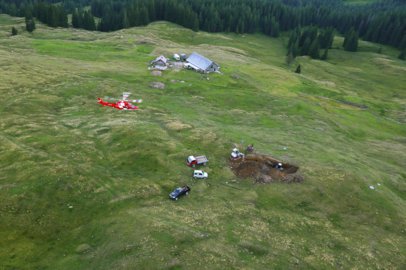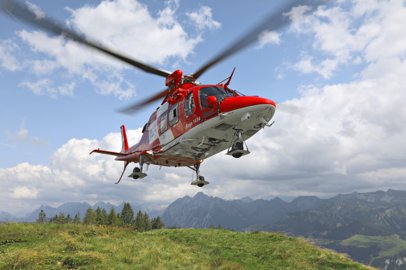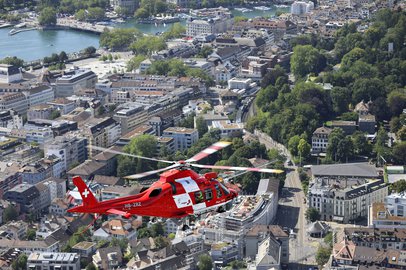The third mission on this mid-summer Saturday afternoon occurs during the long overdue lunch break of the Rega 12 crew on duty. It is shortly before three o’clock in the afternoon when the crew at the helicopter base in Mollis (Canton Glarus) are called out by the Rega Operations Centre. Lunch will just have to wait. Emergency physician Philipp Stein, paramedic and Head of Rescue Service Markus Reichenbach and pilot Rick Maurer immediately head for the Rega helicopter, which is waiting on the tarmac in front of the building.
Alarm following an occupational accident
When Rick Maurer starts up the engines and the AgustaWestland Da Vinci rescue helicopter takes off and heads westwards, the crew only know that the mission concerns an occupational accident in Unteriberg (Canton Schwyz). During the flight, they receive further information from the Operations Centre – such as the age of the casualty, brief details of his injuries and how the accident happened, and the exact coordinates of the accident site. This information is transmitted digitally at the click of a mouse by the flight coordinator to the electronic flight bag (EFB), a special tablet computer in the rescue helicopter. At the same time, the mission coordinates are sent directly to the navigation device in the cockpit. This not only saves time, but also prevents any errors or misunderstandings that could occur when giving the mission coordinates verbally over the radio.
Within a very short time, the rescue helicopter flies over the distinctive peaks of the Glarus and Schwyz Alps and over the Wägitalersee. Just a few minutes later, it approaches the accident site, which is located not far from an Alpine meadow at around 1,500 metres above sea level. It is a remote spot, far away from the road network and thus virtually inaccessible for a ground-based rescue vehicle. Particularly when access or evacuation is difficult due to the impassable terrain, the rescue helicopter is not only by far the fastest, but also the gentlest means of transport.
The Rega helicopter lands and its rotor blades are still turning when emergency physician Philipp Stein and paramedic Markus Reichenbach, who has already shouldered the emergency backpack, quickly make their way to the casualty, who is being attended to by several people. When the Rega crew arrive, the patient is lying on his back next to the large trench that had almost led to disaster on this sunny afternoon.
Buried in a trench
The day had started off quite normally: apprentice farmer Philipp Bellmont is helping his uncle with excavation work near the Spital Alp, high above Unteriberg. He is kneeling down in a trench that he has dug himself and is connecting the pipes for a new underground drinking water tank. When he notices that a side wall of the trench is starting to subside, it is already too late. Philipp Bellmont reacts quickly and straightens up, but within seconds the heavy weight of the earth masses pushes him against the other side wall. The impact takes the young man’s breath away; he tries to shout and shortly afterwards loses consciousness. Fortunately, Philipp’s uncle has seen what happened and reacts correctly: he frees his nephew first with the excavator, which is still standing by the hole in the ground, then with his hands and gently lays him on the ground. He quickly realises that Philipp Bellmont requires medical attention and immediately alerts the cantonal emergency call centre. Based on the description of the accident, the emergency call centre immediately contacts the Rega Operations Centre and requests a rescue helicopter.
Flight to a central hospital
With targeted questions and practised hand movements, Rega emergency physician Philipp Stein first checks the patient for possible injuries. “In order to provide the patient with the best possible medical care, it’s important to know as precisely as possible what happened. The course of the accident can give us additional indications of possible injury patterns. For us, eyewitness statements are therefore always important,” he explains. In the meantime, Philipp Bellmont has regained consciousness, so he is also able to provide the Rega crew with information. He is suffering severe pain in his chest and when breathing, but his circulation is stable and he has no difficulty moving his arms and legs. After a thorough initial examination, the Rega emergency physician decides that the patient should be flown to the University Hospital Zurich for further treatment.
Handover in the shock room
Having being briefed by the crew prior to departure, the flight coordinator at the Rega Operations Centre takes care of the registration at the hospital. Besides the exact arrival time of the Rega helicopter on the roof of the University Hospital, she also passes on to the duty staff details of the patient’s medical condition, so that he will continue to receive the best possible care after being handed over to the hospital doctors. Meanwhile, Philipp Belmont is lying in a stabilised position on the vacuum mattress on the stretcher, which with the combined strength of the crew is lifted into the rescue helicopter shortly before it takes off in the direction of Zurich. Emergency flight physician Philipp Stein does not take his eyes off the patient for a second during the flight and monitors the vital signs, such as pulse and oxygen saturation, on the monitor above the patient. On arrival at the hospital, the crew take Philipp Bellmont to the shock room, where the patient is handed over to the waiting hospital doctors. The Rega emergency flight physician informs his colleagues in detail about the course of the accident and the treatment given so far. Today, Philipp Bellmont remembers little about his flight to Zurich: “I was very tired,” he explains. “Fortunately, the painkillers took effect very quickly.” At the hospital, the doctors later diagnose a total of ten broken ribs and a collapsed lung. Fortunately Philipp Bellmont makes a rapid recovery and is able to return to his work as a farmer a few weeks later. “I have my uncle, Rega and the doctors who treated me at the University Hospital to thank for that,” he says.
More information about our AgustaWestland Da Vinci rescue helicopter




